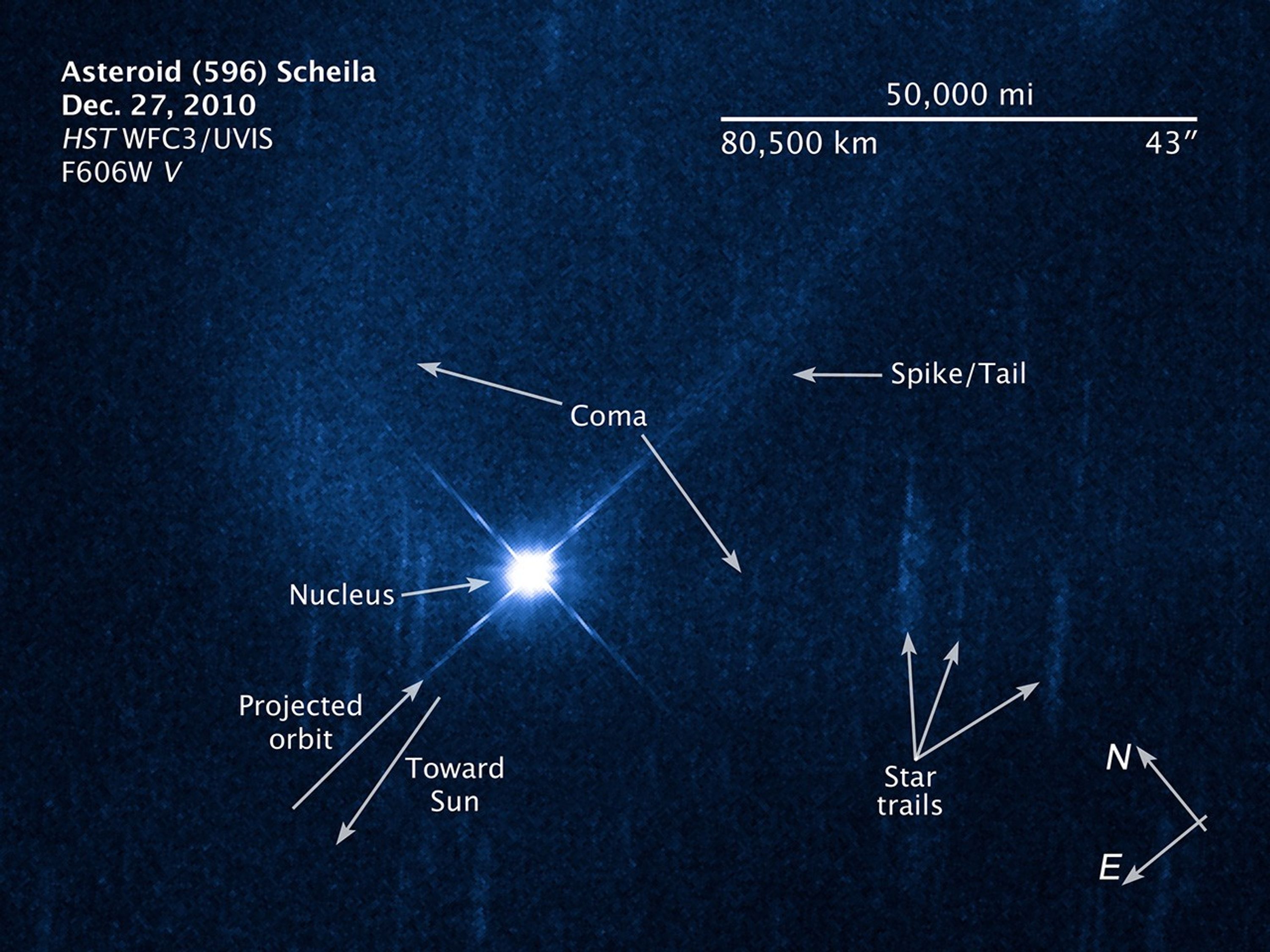1 min read
Hubble Observes Aftermath of Suspected Asteroid Collision

This is a Hubble Space Telescope picture of asteroid (596) Scheila, as observed on Dec. 27, 2010. The visible-light image was taken with Hubble's Wide Field Camera 3 when the asteroid was approximately 217 million miles away. The asteroid is surrounded by a C-shaped cloud, or coma, of dust particles. A linear tail of dust can also be seen streaming behind the asteroid. The asteroid body, which is approximately 70 miles across, appears star-like because it is overexposed so that the faint dust can be imaged.
A second Hubble observation on Jan. 4, 2011, showed that the dusty coma had faded by 30 percent. These data are consistent with the idea that Hubble is observing the aftermath of a collision between Scheila and a much smaller body that blasted debris from the surface. This would be the second time a collision between two asteroids has been witnessed.
About the Object
- DistanceDistanceThe physical distance from Earth to the astronomical object. Distances within our solar system are usually measured in Astronomical Units (AU). Distances between stars are usually measured in light-years. Interstellar distances can also be measured in parsecs.Scheila’s orbit lies in the outer asteroid belt at a semi-major axis of 2.926 AU from the Sun. During the time of the Hubble observations, the asteroid was ~3.1 AU from the Sun, and ~2.3 AU from Earth.
- DimensionsDimensionsThe physical size of the object or the apparent angle it subtends on the sky.The image is 2.2 arcminutes (133,000 mi or 214,000 km) wide.
About the Data
- Data DescriptionData DescriptionProposal: A description of the observations, their scientific justification, and the links to the data available in the science archive.
Science Team: The astronomers who planned the observations and analyzed the data. "PI" refers to the Principal Investigator.The image was created from Hubble data from proposal HST proposal 12435: D. Jewitt (University of California, Los Angeles), H. Weaver (JHU/APL), M. Mutchler (STScI), S. Larson (University of Arizona), and J. Agarwal (ESA/ESTEC, University of Potsdam). - InstrumentInstrumentThe science instrument used to produce the data.HST>WFC3/UVIS
- Exposure DatesExposure DatesThe date(s) that the telescope made its observations and the total exposure time.December 27, 2010, Exposure Time: 26 minutes
- FiltersFiltersThe camera filters that were used in the science observations.F606W (V)
- Object NameObject NameA name or catalog number that astronomers use to identify an astronomical object.Asteroid (596) Scheila
- Object DescriptionObject DescriptionThe type of astronomical object.Main-Belt Comet/Asteroid
- Release DateApril 28, 2011
- Science ReleaseNASA’s SWIFT and Hubble Probe Asteroid Collision Debris
- Credit

This image was originally black and white and recorded only overall brightness. These brightness values were translated into a range of bluish hues. Such color "maps" can be useful in helping to distinguish subtly varying brightness in an image.

Related Images & Videos

Swift Image of Asteroid (596) Scheila
Faint dust plumes bookend asteroid (596) Scheila, which is overexposed in this composite image. Visible and ultraviolet images from Swift's UVOT (circled) are merged with a Digital Sky Survey image of the same region. The UVOT images were acquired on Dec. 15, 2010, when the...

Ground-based Re-discovery Image of Asteroid (596) Scheila
Steve Larson of the University of Arizona's Catalina Sky Survey (CSS) took this image on December 11, 2010, through the Catalina 0.68-meter Schmidt telescope. Later analysis showed the object to be a re-discovery of asteroid (596) Scheila, which was discovered in 1906. In the...
Share
Details
Claire Andreoli
NASA’s Goddard Space Flight Center
Greenbelt, Maryland
claire.andreoli@nasa.gov





























